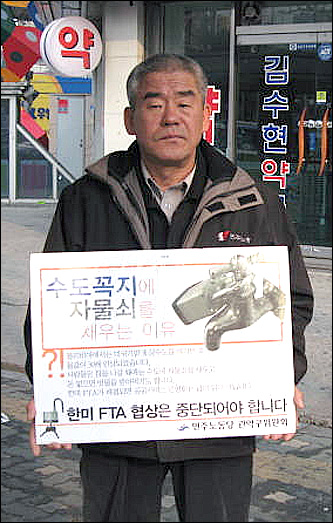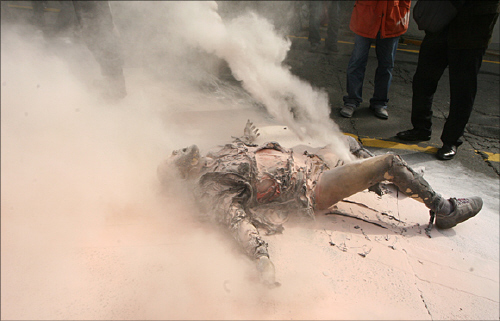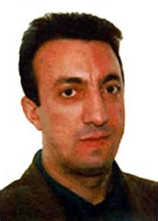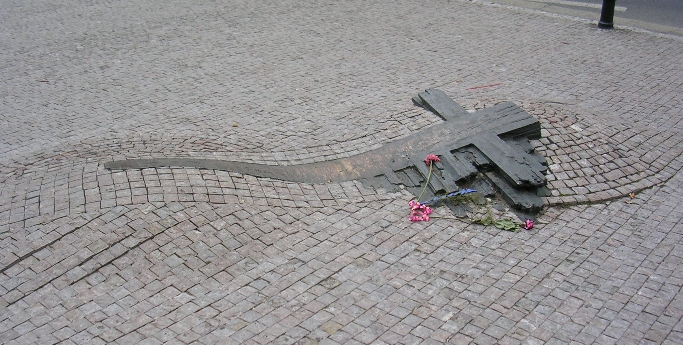*
PART 2 OF 2
Part 2 of 2 - Self Immolation, Hara-Kiri/Seppuku & Sati - DYING WITHOUT KILLING
In addition to the Jihadists, there are other groups (eg Tamil Tigers) and people who have sacrificed themselves in the name of a Cause. The Japanese are known for their Kamikaze and Hara-Kiri/Seppuku. Self-immolation has been used by many nationalities and could be viewed as a last resort or the only means of stirring public awareness.
We can assume people engage in these acts because of ONE or MORE OF THE FOLLOWING REASONS:
- They have a Message to Deliver
- They want to Act in the interests of a group or cause, they care about and identify with
- They hope people will benefit from their actions
- They want to convert people to their cause and spur sympathizers to greater efforts on behalf of the cause
- In the Name of Honour
- They have been conditioned/educated to respect these types of actions
- They have had contact with people who have engaged in these acts
- They want to seek revenge or inflict punishment (an eye for an eye is a recognised deterrent)
- They will receive public recognition, which their normal lives will not bring
JAPANESE HARA-KIRI / SEPPUKU (HONOUR)
The Samurai were bound by a strict code of honor and were expected to set an example for those below them. Part of the samurai honor code, seppuku has been used both voluntarily by samurai to die with honor rather than fall into the hands of their enemies, as a form of capital punishment for samurai who have committed serious offenses, and for reasons that shamed them. Seppuku is also known as hara-kiri, allowed a disgraced samurai to regain his honor by passing into death, where samurai were still beholden to social rules. Seppuku ("stomach-cutting") is a form of Japanese ritual suicide by disembowelment. Seppuku is performed by plunging a sword into the abdomen and making a left to right cut. Seppuku was originally reserved only for samurai.
SATI (also suttee)
A funeral practice among some Hindu communities in which a recently-widowed woman would immolate herself on her husband’s funeral pyre. The term is derived from the original name of the goddess Sati also known as Dakshayani, who immolated herself, unable to bear her father Daksha's humiliation of her (living) husband Shiva. The term may also be used to refer to the widow herself. The term sati is now sometimes interpreted as 'chaste woman'.
SELF IMMOLATIONS - A Cause to Protest
http://users.ox.ac.uk/~sfos0060/immolation.pdf
Self-immolation (Latin immolare "to sacrifice") is an extreme form of protest through self-sacrifice by suicide. Immolation implies suicide by fire but the term also includes other forms of self-sacrifice. The following people engaged in self immolation for a variety of reasons including the US's involvement in the Vietnam War and the Soviets Occupation of Eastern Europe. Let Us Remember....

Heo Se-uk was a 54-year-old South Korean labor union member and taxi driver who set himself ablaze on April 1, 2007 in Seoul to protest the U.S.-Korea Free Trade Agreement. He lived for two weeks after the incident, despite serious burns on 63% of his body. He finally succumbed to a septic infection on April 15.

Uddhav Bhandari (d. 19 March 2007) was a Nepali asylum seeker who died after setting fire to himself at the Eagle Building in Glasgow on March 7th, prior to his immigration hearing. A former police officer, he was afraid of being deported to Nepal after exposing corruption within the police. http://en.wikipedia.org/wiki/Uddhav_Bhandari
In a suicide letter (http://www.savagesound.com/gallery99.htm) published on his website, he described at length his political convictions as to the Iraq War and his choice to take his own life, suggesting at one point, "if I am required to pay for your barbaric war, I choose not to live in your world."
Roland Weisselberg (July 4, 1933 – October 31, 2006) was a retired Lutheran Vicar who received public attention by his self-immolation in a German monastery. A critic of the rulers of the German Democratic Republic, he retired in 1989 because of his state of health. After the German reunification he was worried about the weakness of Christianity in East Germany and about Islam, whose rise was, as he believed, furthered by the "ambiguity of the church". Weisselberg set fire to himself in the Erfurt monastery (where Martin Luther took his monastic vows in 1505), shouting repeatedly "Jesus" and "Oscar" (referring to Oskar Brüsewitz).

On Tuesday 24 June 2003, Neda Hassani, 26, set herself on fire in front of the French Embassy in Great Britain to demand the release of Maryam Rajavi and 150 of her supporters, after a French crackdown on the People's Mujahedeen of Iran, also known as Mujahedeen Khalq Organization (MKO). It has fought an armed campaign for the past 20 years to overthrow the religious rulers of Iran. The French government accused the MKO of plotting terrorist attacks against Iran. http://www.guardian.co.uk/uk/2003/jun/25/world.iran
In 2001, a group of people self-immolated in Tiananmen Square, Beijing, China. China Central Television broadcast the event nationally on Chinese new year and claimed the immolators were practitioners of the Falun Gong. Falun Gong supporters claim it was a setup by the Chinese government.

Alfredo Ormando (San Cataldo, 15 December 1958 – Rome, 23 January 1998) was a gay Italian writer. On 13 January 1998 he set himself on fire in Piazza San Pietro (Rome) to protest the attitudes and policies of the Roman Catholic Church regarding homosexual Christians. After two policemen put out the flames, he was brought to Sant 'Eugenio hospital in critical condition. He died there 11 days later.
Kathy Change was a West Philadelphian performance artist and activist who killed herself in an act of self-immolation on the University of Pennsylvania campus in 1996. http://en.wikipedia.org/wiki/Kathy_Change
Sabine Kratze was a German student who committed self-immolation in order to protest against what she believed to be the unjust trial of six Buddhist monks which had taken place on August 15, 1995. Kratze, who was 25 at the time, set herself on fire with gasoline on September 3, 1995, at Hô Chi Minh City, in a room at a small hotel on Ly You Trong Street. http://en.wikipedia.org/wiki/Sabine_kratze
Reinhold Elstner (born 1920 in the predominantly German inhabited and cultural Sudetenland, which now lies in the Czech Republic) was a German Wehrmacht veteran and Diploma Chemist who poured gasoline over himself and committed suicide at about 8 pm on April 25, 1995, on the steps of Munich's historical Feldherrnhalle, in protest against what he called "the ongoing official slander and demonization of the German People and German soldiers 50 years after the end of World War II". Twelve hours later, on April 26, he died in a Munich hospital.
Homa Darabi (January, 1940 - February 21, 1994) was a pediatrician from Iran licensed to practice medicine in New Jersey, New York, and California. She returned to Iran in 1976 to serve her country as a psychiatrist and after the Islamic Revolution, Islamic authorities shut down her office because she had refused to wear the hijab. On 21 February 1994, Darabi, a 54 year old mother of two daughters immolated herself in Tehran while shouting "Death to Tyranny! Long live freedom! Long live Iran!". Later, her sister Parvin Darabi named the Dr. Homa Darabi Foundation in her remembrance and co-authored with her son, a biography of Dr. Darabi, Rage Against the Veil. http://www.homa.org/
On April 29, 1993, Graham Bamford doused himself with gasoline and set himself on fire in front the British House of Commons in London. Bamford did it in hope to draw attention to atrocities committed the war in Bosnia and Herzegovina particularly the Ahmici massacre. A film about Graham Bamford, his actions, the silence built up around them, and also about the filmmaker and his effort to produce a film about the event are available here: http://www.factumdocumentary.com/pages/faccess/af3_2.htm
Chan I-hua was a Taiwanese pro-democracy activist. He performed self-immolation on May 19, 1989 when the funeral procession of fellow activist Cheng Nan-jung (who had similarly immolated himself) was blocked by the police in front of the Presidential Office Building in Taipei. http://en.wikipedia.org/wiki/Chan_I-hua
Cheng Nan-jung (b. September 12, 1947 in Taipei - d. April 7, 1989) was a Taiwanese publisher and pro-democracy activist. He was the founder of the Freedom Era Weekly. He is known internationally for setting himself on fire to voice for Taiwanese independence. In 1989, Cheng was charged with insurrection for printing a new Constitution for the Republic of Taiwan. An arrest warrant was issued. He refused to appear in court. When the police arrived to arrest him on April 7, he committed suicide by self-immolation. He set fire to the building and died in the blaze. At Cheng's funeral on May 19, another Taiwanese pro-democracy activist, Chan I-hua, also immolated himself when the funeral procession was blocked by police. http://en.wikipedia.org/wiki/Cheng_Nan-jung
* * * * * * *
Artin Penik (Died 15 August 1982) was a Turkish-Armenian who set himself on fire in protest of the terrorist attacks in Esenboğa International Airport by the Armenian Secret Army for the Liberation of Armenia (ASALA, also known as Third October) on August 10, 1982. Penik, a 61-year-old self-employed tailor, set himself on fire in Taksim plaza, the main square of Istanbul, Turkey, after leaving a suicide note in which he wrote "I can no longer bear the grief over slayings of innocent people." http://en.wikipedia.org/wiki/Artin_Penik
Hartmut Gründler (11 January 1930 in Hümme–21 November 1977 in Hamburg) was a German teacher from Tübingen, engaged in environmental protection. On November 16,1977 ( the Day of Prayer and Repentance) Gründler burned himself in Hamburg during the SPD Party Congress out of protest against "the continued governmental misinformation" in the energy policy, particularly concerning the permanent disposal of nuclear waste. Not out of despair, but to set an example did he choose death by burning himself, about which he informed in writing some press organs as well as politicians and also the chancellor in advance, attaching his political last will. http://en.wikipedia.org/wiki/Hartmut_Grundler
Alain Escoffier (25 October 1949 – Paris, 10 February 1977) was a French anti-communist activist and martyr. He was a bank clerk and he had married an East-Germany refugee. He belonged to the right-wing Parti des forces nouvelles. On 10 February 1977, thirtieth anniversary of the Treaty of Paris he self-immolated on the Champs-Élysées before the offices of Soviet airlines Aeroflot. He died crying "Communistes assassins" (Murderer Communists). His gesture was inspired by those recurring in Eastern Europe, such as Jan Palach and others, and it was intended to protest against the Soviet occupation of Eastern Europe and the Cold War division of Europe.
Oskar Brüsewitz was an East German Lutheran pastor who committed self-immolation to protest the repression of religion in the Communist state of East Germany. On August 18, 1976 Brüsewitz committed suicide by self-immolation in a public market in front of the church in Zeitz. He died on August 22 1976. http://en.wikipedia.org/wiki/Oskar_Brüsewitz
Joseba Elosegi was a Basque nationalist who self-immolated trying to embrace dictator Franco during a pelota game in San Sebastián September 19, 1970. He did it as a protest against the fascist Bombing of Gernika in 1937. http://en.wikipedia.org/wiki/Joseba_Elosegi
Kostas Georgakis (23 August 1948 Corfu, Greece – 19 September 1970 Genoa, Italy), was a Greek student of Geology, who set himself ablaze in Genoa, Italy as a protest against the Greek military junta of 1967-1974. Georgakis is considered the precursor of the later student protests, such as the Polytechnic uprising. At the time his death caused a sensation in Greece and abroad as it was the first tangible manifestation of the depth of resistance against the junta. http://en.wikipedia.org/wiki/Kostas_Georgakis
George Winne, Jr., (1947 – May 11, 1970) is remembered as a protester of the Vietnam War who set himself on fire in a deliberate act of self-immolation in Revelle Plaza on the campus of the University of California, San Diego on May 10, 1970, to protest the United States involvement in the war. He died ten hours later, asking his mother to write a letter to President Nixon. His last words were "I believe in God and the hereafter and I will see you there."
* * * * * * *

The memorial to Jan Palach and Jan Zajíc in front of the National Museum, Prague, Czech Republic. There are several other memorials to Palach in cities throughout Europe, including a small memorial inside the glacier tunnels beneath the Jungfraujoch in Switzerland.
Jan Zajíc (3 July 1950-25 February 1969) was a Czech student who committed suicide by self-immolation as a political protest. He was a student at the technical college, specializing in railroads, and was also interested in poetry and humanities. In 1969 he took part in a hunger strike and a commemoration ceremony by students for Jan Palach near the statue of Saint Wenceslas in Prague. It was probably this event which planted the idea of becoming Palach's successor in Zajíc's mind.
 Jan Palach was a Czech student who committed suicide by self-immolation as a political protest against the Soviet invasion of Czechoslovakia in August 1968. Palach died after setting himself on fire in Wenceslas Square in Prague, Czechoslovakia on 16 January 1969 in protest. The funeral of Palach turned into a major protest against the occupation, and a month later (on February 25, 1969) another student, Jan Zajíc, burned himself to death in the same place, followed in April of the same year by Evžen Plocek in Jihlava.
Jan Palach was a Czech student who committed suicide by self-immolation as a political protest against the Soviet invasion of Czechoslovakia in August 1968. Palach died after setting himself on fire in Wenceslas Square in Prague, Czechoslovakia on 16 January 1969 in protest. The funeral of Palach turned into a major protest against the occupation, and a month later (on February 25, 1969) another student, Jan Zajíc, burned himself to death in the same place, followed in April of the same year by Evžen Plocek in Jihlava.After the Velvet Revolution, Palach (along with Zajíc) was commemorated in Prague by a bronze cross embedded at the spot where he fell outside the National Museum, as well as a square named in his honour. http://en.wikipedia.org/wiki/Jan_Palach
* * * * * * *
Ryszard Siwiec (1909—September 12, 1968) was a Polish accountant, teacher and former Home Army soldier who was the first person to set himself on fire in protest against the Soviet-led invasion of Czechoslovakia. He set himself ablaze in Warsaw during a national harvest festival on September 8, 1968 at the Dziesięciolecia Stadium, and died in hospital four days later. His act was witnessed by nearly 100,000 spectators, including the national leadership and foreign diplomats who had been invited to the festival intended as a vast propaganda spectacle. http://en.wikipedia.org/wiki/Ryszard_Siwiec
Florence Beaumont (died October 15, 1967, Los Angeles) was an American who self-immolated herself in protest of the escalating Vietnam war. She had two children. After soaking herself in gasoline, she set herself alight in front of the Federal Building, Los Angeles.
Roger Allen LaPorte (1943 – November 9, 1965) is best known as a protester of the Vietnam War who set himself on fire in front of the United Nations building in New York City on November 9, 1965, to protest the United States involvement in the war. At the time, he was a 22-year old Catholic Worker Movement member.
Norman Morrison (December 29, 1933 - November 2, 1965), born in Erie,  Pennsylvania, was a Baltimore Quaker best known for committing suicide at age 31 in an act of self-immolation to protest United States involvement in the Vietnam War. On November 2, 1965, Morrison doused himself in kerosene and set himself on fire below Secretary of Defense Robert McNamara's Pentagon office. Morrison took his daughter Emily, then one year of age, to the Pentagon, and either set her down or handed her off to someone in the crowd before setting himself ablaze. She was a powerful symbol of the children we were killing with our bombs and napalm--who didn't have parents to hold them in their arms."
Pennsylvania, was a Baltimore Quaker best known for committing suicide at age 31 in an act of self-immolation to protest United States involvement in the Vietnam War. On November 2, 1965, Morrison doused himself in kerosene and set himself on fire below Secretary of Defense Robert McNamara's Pentagon office. Morrison took his daughter Emily, then one year of age, to the Pentagon, and either set her down or handed her off to someone in the crowd before setting himself ablaze. She was a powerful symbol of the children we were killing with our bombs and napalm--who didn't have parents to hold them in their arms."
*
Alice Herz (1883 – March 26, 1965) was an elderly Quaker and the first activist in the United States known to have immolated themself in protest of the escalating Vietnam War, following the example of Buddhist monk Thich Quang Duc. A longtime peace activist, she attempted self-immolation on March 16, 1965, in Detroit, Michigan, at the age of 82. A man and his two boys were driving by and saw her burning and put out the flames. She died of her wounds ten days later.
Confiding to a friend before her death, Herz remarked that she had used all of the accepted protest methods available to activists--including marching, protesting, and writing countless articles and letters--and she wondered what else she could do. Evidently, Herz decided to make self-immolation her final act of protest. The war continued for another ten years following her death. http://en.wikipedia.org/wiki/Alice_Herz
 Thich Quang Duc died on June 11, 1963 and was a Vietnamese Mahayana Buddhist monk who burned himself to death at a busy Saigon road intersection on June 11, 1963. He was protesting the persecution of Buddhists by South Vietnam's Ngo Dinh Diem administration. Photos of his self-immolation were circulated widely across the world and brought attention to the policies of the Diem regime. Malcolm Browne won a Pulitzer Prize for his iconic photo of the monk's death, as did David Halberstam for his written account. After his death, his body was re-cremated, but his heart remained intact.
Thich Quang Duc died on June 11, 1963 and was a Vietnamese Mahayana Buddhist monk who burned himself to death at a busy Saigon road intersection on June 11, 1963. He was protesting the persecution of Buddhists by South Vietnam's Ngo Dinh Diem administration. Photos of his self-immolation were circulated widely across the world and brought attention to the policies of the Diem regime. Malcolm Browne won a Pulitzer Prize for his iconic photo of the monk's death, as did David Halberstam for his written account. After his death, his body was re-cremated, but his heart remained intact.
'Before closing my eyes to go to Buddha', wrote Quang Duc, 'I have the honour to present my words to President Diem, asking him to be kind and tolerant towards his people and enforce a policy of religious equality.'
Thich Quang Duc act increased international pressure on Diem and led him to announce reforms with the intention of mollifying the Buddhists. The promised reforms were implemented either slowly or not at all, leading to a deterioration in the dispute. With protests continuing, the Special Forces loyal to Diem's brother, launched nationwide raids on Buddhist pagodas causing deaths and widespread damage. Several Buddhist monks followed Thich Quang Duc example and burned themselves to death. Eventually, an Army coup toppled and killed Diem in November. The self-immolation is widely seen as the turning point of the Vietnamese Buddhist crisis which led to the change in regime.
In 1964 in India, a Tamil labourer called Chinnaswami set himself alight to protest against the encroachment of the Hindi language. A year later, when Hindi was supposed to replace English as the official language of India, five Tamils died by fire and three swallowed poison. Tamils have a tradition of self-sacrifice.
On July 3, 1936, Stefan Lux, a Jewish Czech journalist, actor and director, shot and killed himself with a revolver in the general assembly room of the League of Nations in Geneva, Switzerland during its session, to protest the treatment of Jews in Germany under Adolf Hitler. http://en.wikipedia.org/wiki/Stefan_Lux










No comments:
Post a Comment